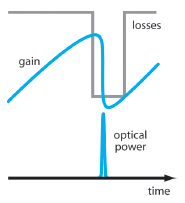Optipedia • SPIE Press books opened for your reference.
Q Switching
Excerpt from Field Guide to Laser Pulse Generation
Q switching is a method for generating intense short pulses (sometimes called "giant pulses") of light with a laser. The basic principle is as follows:
In a first phase, the gain medium is pumped, while the extraction of energy as laser light is prevented by keeping the resonator losses high (that is, the Q factor is kept low). This can be done with active or passive means.

The resonator losses are then suddenly reduced. As the gain is then substantially higher than the resonator losses, the intracavity power rises exponentially (normally starting from weak fluorescence light of the gain medium), until the gain is saturated and the power decays again.
The generated light pulse can extract a large percentage of the energy that was originally stored in the gain medium. For a high pulse energy, the gain medium must have a high energy storage capability, that is, a long upper-state lifetime, a high density of laser-active ions or atoms, and a not-too-high gain efficiency. (The latter is important because amplified spontaneous emission could otherwise limit the stored energy, and the initial loss required for preventing premature lasing would be very high.) The most-used laser gain media for Q-switched lasers are rare-earth-doped crystals and glasses. Bulk lasers are most common, although fiber lasers can also be Q switched and can in combination with fiber amplifiers provide very high average powers.
Active and Passive Q Switching
Active Q switching is based on active loss modulation with a so-called Q switch. Typically, an acousto-optic modulator is incorporated into the laser resonator. While the RF power is applied to the modulator, this introduces large losses by diffraction into the first-order beam, which leaves the resonator. The pulse is triggered by suddenly switching off the RF power. For high pulse repetition rates, the crystal is continuously pumped, and the Q switch is triggered repetitively. For the highest pulse energies, pulsed pumping (for example, with a flashlamp) and low pulse repetition rates are used.
modulator is incorporated into the laser resonator. While the RF power is applied to the modulator, this introduces large losses by diffraction into the first-order beam, which leaves the resonator. The pulse is triggered by suddenly switching off the RF power. For high pulse repetition rates, the crystal is continuously pumped, and the Q switch is triggered repetitively. For the highest pulse energies, pulsed pumping (for example, with a flashlamp) and low pulse repetition rates are used.
 Passive Q switching is an alternative technique, where the active modulator is replaced with a saturable absorber (a passive Q switch). In a Nd:YAG laser, for example, this could be a Cr4+:YAG crystal. There are other saturable absorber crystals for other wavelengths and semiconductor saturable absorber mirrors (SESAMs) for various operation wavelengths.
Passive Q switching is an alternative technique, where the active modulator is replaced with a saturable absorber (a passive Q switch). In a Nd:YAG laser, for example, this could be a Cr4+:YAG crystal. There are other saturable absorber crystals for other wavelengths and semiconductor saturable absorber mirrors (SESAMs) for various operation wavelengths.
The saturable absorber initially introduces a high optical loss. Once the gain reaches this loss level and the pulse begins to build up, the absorber is saturated, that is, its loss is reduced, which further accelerates the pulse buildup. This method is simple and cost effective (eliminating the modulator and its electronics) and is suitable for very high pulse repetition rates, but it typically leads to lower pulse energies and does not allow external triggering of the pulses.
In any case, the laser dynamics and the energy balance impose certain restrictions on the pulse parameters. For example, a higher pulse repetition rate will normally reduce the pulse energy and increase the pulse duration.
R. Paschotta, Field Guide to Laser Pulse Generation, SPIE Press, Bellingham, WA (2008).
View SPIE terms of use.

